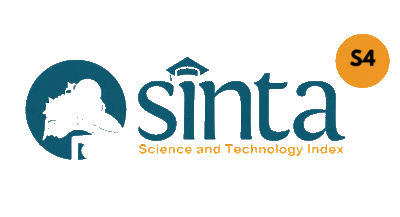SISTEM PAKAR TINGKAT STRES PADA MAHASISWA SKRIPSI BERBASIS WEBSITE (STUDI KASUS: FAKULTAS TEKNIK UNIVERSITAS PALANGKA RAYA)
DOI:
https://doi.org/10.47111/jti.v17i1.8241Keywords:
Expert System, Stress Level, Thesis, Certainty Factor, Forward ChainingAbstract
An expert system is an application program that tries to imitate the reasoning of an expert in solving a problem. Students at the Faculty of Engineering who are taking a thesis must have experienced stress when working on a thesis, this is obtained from internal and external factors, stress is divided into 4, namely normal, mild, moderate, and severe stress. To find out what level of stress they are experiencing while working on the thesis.
Therefore, in this thesis research, we will discuss how to design and build an Expert System application for Stress Levels for Website-Based Thesis Students (Case Study: Faculty of Engineering, University of Palangka Raya) aims to create an expert system using the forward chaining method and certainty factor, by making an application. In this way, students can find out the level of stress that is being experienced when working on a thesis and be given solutions according to the level of stress.
The result is an expert system application that can replace the presence of experts to diagnose stress levels. Students make independent diagnoses by answering the symptoms they are experiencing. This study uses 10 student data from the Department of Civil Engineering 3, Architecture 2, Informatics Engineering 3, and Mining Engineering 2. The results can be concluded that the dominant students experience severe stress levels when working on theses. There is a recapitulation to see the percentage of students who experience stress levels at stress levels and periods.
Downloads
References
Altman DG. Practical Statistics for Medical Research. London: Chapman and Hall; 1991:404–408.
Ambarwati, P. D., Pinilih, S. S. and Astuti, R. T. (2017) ‘Gambaran Tingkat Stres Mahasiswa’, Jurnal Keperawatan Jiwa, 5(1), p. 40. doi: 10.26714/jkj.5.1.2017.40-47.
Cohen, J, “A Coefficient of Agreement for Nominal Scales,” Educ. Psychol. Meas., vol. 20, no. 1, pp. 37–46, 1960, doi: 10.1177/001316446002000104.
F. Harahap and R. N. Sari, “Stres Pada Mahasiswa Semester Akhir Dengan Menggunakan Metode Certainty Factor,” J. Teknol. Inf. J. Keilmuan dan Apl. Bid. Tek. Inform., vol. 5, pp. 68–75, 2018.
Larasati, P. P. (2019) ‘Sistem Pakar Diagnosis Penyakit Skizofrenia Menggunakan Metode Certainty Factor Berbasis Web’, 3(1), pp. 227–234.
Nasir, J. and Jahro, J. (2018) ‘Sistem Pakar Konseling Dan Psikoterapi Masalah Kepribadian Dramatik Menggunakan Metode Forward Chaining Berbasis Web’, Rabit : Jurnal Teknologi dan Sistem Informasi Univrab, 3(1), pp. 37–48. doi: 10.36341/rabit.v3i1.225.
Nugraheni, R. A., “Identifikasi Morfologi Telur Dan Larva Nyamuk Pembawa Vektor Penyakit Zoonosis Berbasis Citra Mikroskopis,” J. Biol., vol. 1, no. 1, pp. 1–74, 2017.
Nuraini, R. (2015) ‘Desain Algorithma Operasi Perkalian Matriks Menggunakan Metode Flowchart’, Jurnal Teknik Komputer Amik Bsi, 1(1), pp. 144–151.
Nurholis, N., Fauziah, F. and Natashia, N. D. (2021) ‘Perpaduan Metode Certainty Factor dan Forward Chaining untuk Menentukan Tingkat Stres Mahasiswa Tingkat Akhir Berbasis Android’, Jurnal JTIK (Jurnal Teknologi Informasi dan Komunikasi), 5(3), p. 267. doi: 10.35870/jtik.v5i3.218.
Permatasari, R., Arifin, M. and Padilah, R. (2020) ‘Studi Deskriptif Dampak Psikologis Mahasiswa Program Studi Bimbingan dan Konseling Universitas PGRI Banyuwangi Dalam Penyusunan Skripsi di Masa Pandemi COVID-19’, Jurnal Bina Ilmu Cendekia, 2(1), pp. 127–141.
Purnama, A.P. (2020) “Sistem Pakar Diagnosis Penyakit Gigi,”.
Rachman, R. and Mukminin, A. (2018) ‘Penerapan Metode Certainty Factor Pada Sistem Pakar Penentuan Minat dan Bakat Siswa SD’, Khazanah Informatika: Jurnal Ilmu Komputer dan Informatika, 4(2), p. 90. doi: 10.23917/khif.v4i2.6828.
Sommerville, I. (2011) Software Engineering (9th ed.; Boston, Ed.). Massachusetts: Pearson Education.
Sucipto, A. et al. (2019) ‘Penerapan Metode Certainty Factor Pada Diagnosa Penyakit Saraf Tulang Belakang’, Jurnal Ilmiah FIFO, 10(2), p. 18. doi: 10.22441/fifo.2018.v10i2.002.
Sugiharni, G. A. D. and Divayana, D. G. H. (2017) ‘Pemanfaatan Metode Forward Chaining Dalam Pengembangan Sistem Pakar Pendiagnosa Kerusakan Televisi Berwarna’, Jurnal Nasional Pendidikan Teknik Informatika (JANAPATI), 6(1), p. 20. doi: 10.23887/janapati.v6i1.9926.
Waruwu, A. (2021). Hubungan Dukungan Keluarga Dengan Stres Pada Mahasiswa Yang Menyusun Skripsi Di Fakultas Psikologi Universitas Medan Area (Doctoral dissertation, Universitas Medan Area).
Wijaya, A., Putra, N. and Laksmita, N. C. (2022) ‘Sistem Pakar : Deteksi Dini Stres Pada Masa Pandemi Covid-19 Menggunakan Metode Forward Chaining Expert System : Detection Early Depression in Covid-19 Pandemic’, 9(1), pp. 11–16. doi: 10.25126/jtiik.202293789.
Yulisman, Y dan Muttaqien, R. . (2019) ‘Sistem Pakar untuk Mendiagnosa Masalah Gizi pada Balita dan Ibu Hamil dengan Metode Forward Chaining.’, Program Studi Informatika Fakultas Komunikasi dan Informatika Universitas Muhammadiyah Surakarta, 04(1), pp. 1–19












